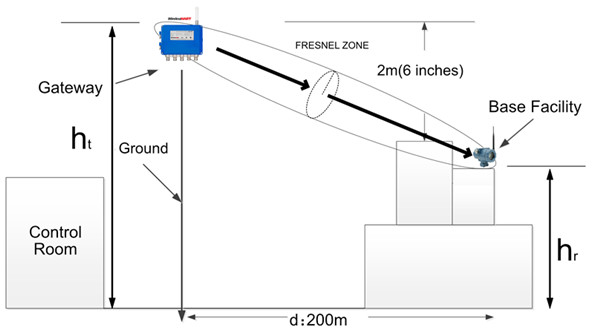
Profound and Detailed
2023-09-25
I believe that many customers clearly remember some parameters when reading the product manual, but forget them when using it. In fact, only after you understand the principles behind these parameters will you become familiar with them. This small wireless communication class will answer two questions from a principle perspective: First, what is the farthest distance between the wireless module and the G1100 gateway? Second, how high should the G1100 gateway be set up?

1. Why is the farthest distance between the wireless module and the G1100 gateway 200m?
In order to answer this question, we need to look at the entire process of wireless signals from being transmitted by the gateway to being received by the module. A complete transmission process is shown in the figure below:

The wireless signal is transmitted from the G1100 gateway, and the fixed transmission power is 10dBm. where dbm is the power unit, indicating decibels relative to 1mW, so 0dBm is equal to 1mW, and the formula is dBm = 10lg10P mv. 802.11 devices transmit between 1mW and 100mW.
The signal will lose 3dB in the circuit. dB is a comparative unit. The specific formula for power loss is represented by power ratio, dB = 10lg(P1/P2). Simply put: every 3dB of gain or loss means that the power is doubled or halved; every 10dB of gain or Loss means power multiplied by 10 or divided by 10. At this time, the signal strength is 10-3=7dBm.
After the signal is lost in the cable, a power gain will be generated in the antenna, the unit is dBi. It should be noted here that the antenna is a passive component, which concentrates the radiated energy in one direction at the expense of other directions to obtain gain. dBi is similar to dB and is also a comparison unit. The larger the value, the higher the gain. The calculated signal strength at this time is 7+3=10dBm.
After 50m of free space loss of 70dB, receiving end antenna gain of 3dB, and cable loss of 3dB, the signal strength RSSI of the receiving end is -60dBm. Each wireless device has a receiving sensitivity. Taking the M1100S module as an example, its receiving sensitivity is -93.1dBm. At this time, the RSSI of -60dBm is greater than the receiving sensitivity, so the signal can be heard by the receiving end.
So when calculating how far the wireless device can be from the gateway, the frequency of the G1100 gateway is 2.4GHz and the transmit power is 10dBm. According to the free space wireless communication distance transmission formula Loss (dB) = 32.44 + 20logD (Km) + 20logF (MHz). At a transmit power of 10dBm, the signal strength at the receiving end about 200m will be lower than -100dBm. Therefore, the transmission distance of G1100 gateway is about 200m.
2. What is the recommended height for erecting the G1100 gateway?
To explain this problem, we need to introduce the concept of Fresnel zone, which is an ellipsoid between the transmitting antenna and the receiving antenna (the sum of the reflection and incident distances between the two foci on the ellipsoid is the same).
Taking a vertically polarized antenna system as an example, we need to understand that there is a half-wavelength lag in the electromagnetic waves reflected at the distance of the first Fresnel zone boundary. Therefore, when the phase shift of the reflected wave (orange wave) on the receiving antenna is equal to one wavelength so that it is in phase with the direct wave (green wave) on the receiving antenna, the total received signal strength (red wave) becomes Stronger.

So is the higher the wireless transmitter, the better? Nor, if the reflection height is in the second Fresne zone, the phase shift of the reflected wave (orange wave) on the receiving antenna is equal to half a wavelength, making it opposite to the direct wave (green wave) on the receiving antenna. phase, the total received signal strength (red wave) will become weaker.

Therefore, in actual situations, we will set up the transmitter so that there are no objects that block the radio waves in the First Fresnel zone, and try not to exceed 20% of the Fresnel zone. Otherwise, multipath propagation of electromagnetic waves will have adverse effects, leading to a decrease in communication quality or even interruption of communication.
When actually erecting our G1100 gateway, the recommended erection height is as follows:

According to the conclusion of question 1, the distance from the receiving end to the transmitting end is d=200m, and the phase transformation caused by the direct wave and reflected wave shown in the figure is δ=4πhthr/λd. The reflection height of the obstacle must be 80% of the Fresnel zone. Therefore, when the wavelength of the 2.4GHZ electromagnetic wave is 140m and the distance is 200m, △h=ht-hr= 2m can be calculated through the geometric relationship. Normally, the infrastructure HR will be 2-4 meters above the ground, so the recommended placement height of the gateway is 4-6 meters above the ground.
<< Previous page
Next page >>